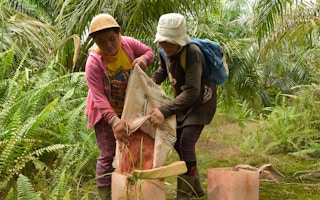“When oil palm was given out by the district head I didn’t accept it. I am still angry at the oil palm companies,” says Monica Mensea. At 83, Mensea is the oldest woman in her village of Long Bentuk, a Dayak Medang indigenous community in East Kalimantan, a province in Indonesian Borneo. Though her body is weakening and her brown eyes are cloudy with cataracts, Mensea’s mind is as sharp as ever. For nearly 20 years she led her community as the kepala adat (customary head) of Long Bentuk, in the administrative district of East Kutai. Despite her firm stance against converting land to industrial oil palm, today a corporate-run estate abuts her village’s land, where her community’s ancestral forest once stood. New pest infestations, oil palm plantations and climate change are all affecting local livelihoods and food availability. Women are suffering the most, through increased workloads and food shortages.
Oil palm explodes
Oil palm plantations have expanded voraciously in Indonesia, increasing by 4,500 square kilometers (1,740 square miles) per year from 1995 to 2015. Kahar Al Bahri, an activist with the Mining Advocacy Network, an NGO with a strong presence in East Kalimantan, is concerned that determination of land-use allocations pays little attention to natural features, such as rivers, or the land claims of local communities. “Almost all permits issued in East Kalimantan are in blocks or grids,” Kahar said. “Companies just request the blocks they want to become their plantations.”
Converting landscapes to oil palm has extensive implications for the lives and livelihoods of land-dependent people who live in and around company concessions. Proponents of industrial oil palm emphasize its development benefits for rural areas. Last year, Awang Faroek Ishak, the outgoing governor of East Kalimantan (soon to be replaced by the recently elected Isran Noor, who was the East Kutai district head from 2009 to 2015), said in an interview that “palm oil is a development solution, as companies are able to offer — through corporate sustainable responsibility programs — roads and schools and health clinics.”
Yet in the East Kutai subdistrict of Busang, where Long Bentuk and five other villages are located, these programs have not emerged. Busang is not an anomaly — a recent study assessing the development contribution of oil palm indicates that even plantations certified to the highest industry standard, that awarded by the Roundtable on Sustainable Palm Oil, have not led to a decrease in rural poverty, and that the number of healthcare facilities per capita declined between 2000 and 2014 in regions where oil palm has proliferated. While oil palm companies have been present in Busang for over a decade, still no state road connects to the city of Samarinda, where the nearest market, hospital, university and other services are located. The only access is through an endless timber plantation: a bone-rattling nine-hour drive through spindly acacia trees growing in uniform lines.
Indonesia’s 2001 decentralization laws gave local governments the authority to greenlight oil palm, logging and mining operations. This new power was not matched with support or the budget to ensure that companies delivered development contributions. Benefit arrangements are actually left to companies to forge with local communities. Without government oversight to ensure that companies acquire land in a way that is not coercive — or that any negotiations are conducted at all — communities are vulnerable to strategies taken up by the private sector to pressure them to release land. Local communities’ capacity to determine how their land is used, and to ensure that negotiations reflect all the preferences and concerns of social groups, is limited. Increasingly, communities find that, even where they refuse to release land, as with the community of Long Bentuk, companies go around them, leaving their village residential and farming land in place but surrounded by plantations.
Permitting oil palm
In late January 2006, just weeks before he was to leave office, the then district head of East Kutai signed off on four oil palm companies’ early-stage land-use permits for most of Long Bentuk’s land. The permits were issued one after the other, four days in a row. The four companies lead back to two main business groups: the Teladan Prima Group and the Triputra Group. In Indonesia, larger companies create a number of smaller subsidiaries to get around laws that prohibit any single company from operating concessions larger than 200 square kilometers (77 square miles).
In Long Bentuk, it wasn’t until local residents discovered workers cutting trees in their ancestral forest that they realized their land had been issued permits for oil palm, according to Wang Beng, a Dayak Medang elder from Long Bentuk. A long struggle against the oil palm companies ensued over the subsequent decade. The Dayak Medang villagers tried every strategy they could, rallying their community to protest the land clearing, reporting to the district government and law enforcement agencies, and eventually traveling to Jakarta, the Indonesian capital, to report to national authorities. The companies’ continued pressure brought previously mutually agreed borders between villages into dispute.
“When the company first came, we knew the impacts would be bad, but the neighboring villages accepted, so now we are encircled by oil palm,” said Mensea, the former long-serving kepala adat. This strategy of enclaving communities who refuse to release land is frequently taken by oil palm companies: Residents are left in place with just enough land for current generations to continue farming, at least in the short term.
This story was published with permission from Mongabay.com. Read the full story.










